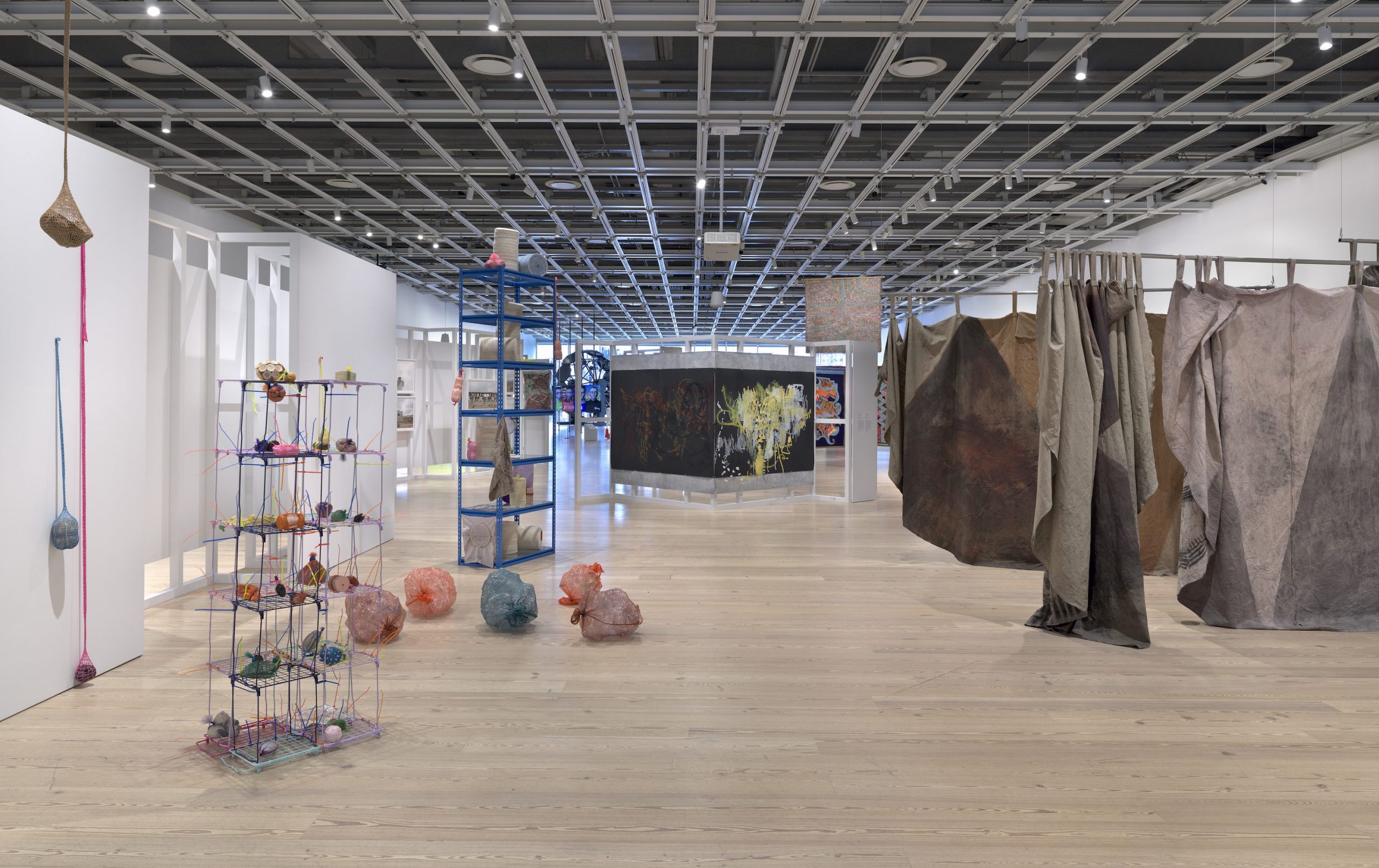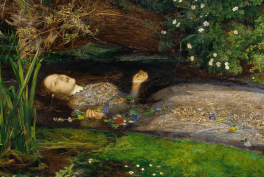Summary
- The main concepts of Quiet As It’s Kept are nation, state, land, human rights, the rights of nature, policing, colonization, and citizenship.
- Remembrance of those who passed away is present in the works of Coco Fusco, Rebecca Belmore, Alfredo Jaar.
- The topic of open borders can be found in the artworks of Lisa Alvarado, Duane Linklater, Monica Arreola, Theresa Hak Kyung Cha.
- Attention to drug abuse is brought by Alejandro “Luperca” Morales, Andrew Roberts.
Lush Conceptualism
To accompany the title Quiet As It’s Kept, Whitney Biennial 2022 has borrowed the symbol of the inverted parentheses from a 1968 poem by N. H. Pritchard to suggest openness, one that is enhanced by intersectional discussions and both timely and timeless. National borders have been blurred to permit the inclusion of participants living in Canada and Mexico. Concepts such as nation, state, land, human rights, the rights of nature, policing, colonization, and citizenship emerge through a variety of materials and methods. Rather than apply “post” as a prefix to describe the Conceptualism within the framework of this exhibition, Edwards defines it as follows:
…in lush conceptual works the object is thick, dense, multivalent, and polyvocal rather than dematerialized.
“The Alchemy of Issues,” Whitney Biennial 2022 Quiet as It’s Kept, exh. cat., p. 105.
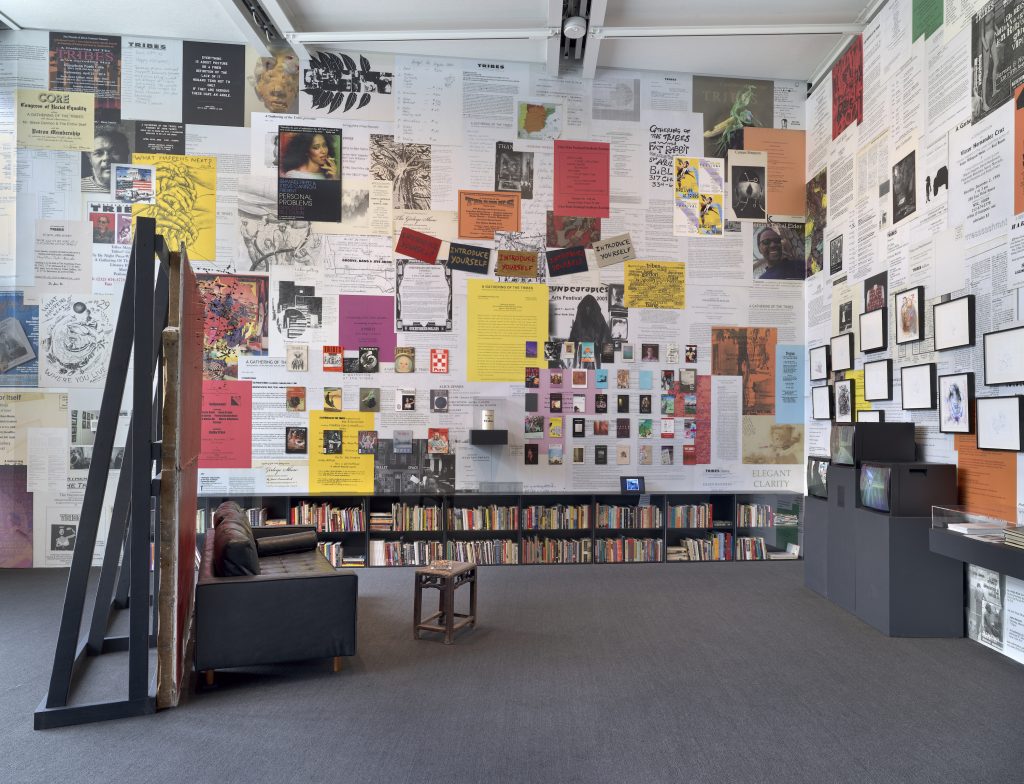
Installation view of Whitney Biennial 2022: Quiet as It’s Kept, Whitney Museum of American Art, New York, NY, USA, from left to right: Alex Da Corte, ROY G BIV, 2022; Leidy Churchman, Mountains Walking, 2022. Photograph by Ron Amstutz.
Parked in front of the Whitney Museum is a Chevrolet Caprice Classic Sedan, one of several installations in this year’s Biennial by the late artist Jason Rhoades (1965-2006). The automobile as a readymade object and as an extension of the artist’s provocative studio practice references American consumerism and material culture.
Throughout the exhibition are questions related to the process of being an American or becoming an American dispersed by the Lebanese artist Rayyane Tabet (b. 1983). 100 Civic Questions is based on the artist’s own experience of taking the United States naturalization test. Simple yet poignant, questions pertaining to this nation’s history and government automatically raises other questions and concerns related to patriotism, privilege, ignorance, superiority, and democracy to just name a few. In his catalogue essay, Joshua Chambers-Letson does not dance around the truth of this nation’s foundation in the following statement:
“America” may be an ideal, but it is also a colonial horror and a storm of death and racial terror. It is an occupation, a legal and social compact built to maintain the institutions and effects of white rule, racial capitalism, and settler colonialism. It is forged from erased histories of objectification and exclusion, accumulation and dispossession, and incarceration and internment, as well as the churning of an imperial war machine.
“This Body Remembering: The Art of a Dying Time and Place,” Whitney Biennial 2022 Quiet as It’s Kept, exh. cat., p. 74.
Water Is Life
The majority of the Biennial is concentrated on, but not limited to, two floors of the museum. One has been transformed into a dark labyrinth of galleries anchored on one end by an installation of the New York City apartment that served as the headquarters for A Gathering of the Tribes, a collective founded by the poet, playwright, novelist, and professor Steve Cannon (1935-2019).
This was a place of empowerment and collaboration for writers and artists, including David Hammons. What started out as a literary magazine blossomed into a gallery, and as the name implies, a space to gather and exchange ideas. Surrounding a small couch and floating red wall are shelves filled with books, walls plastered with posters from past events, and television monitors playing archival footage that together reimagine the intellectual and creative community of Cannon and his friends from 1991 until his death in 2019.
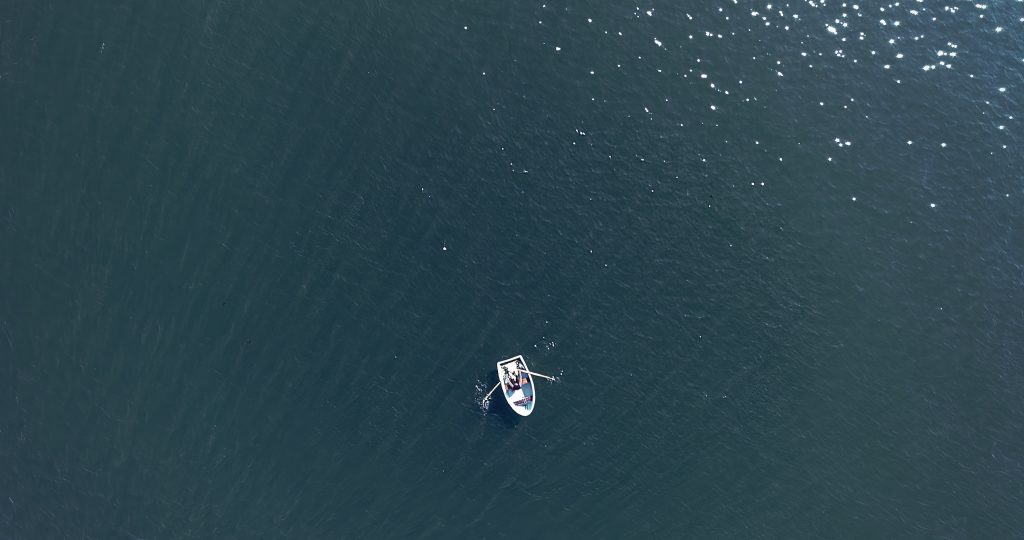
Coco Fusco, still from Your Eyes Will Be an Empty Word, 2021. HD video, Collection of the artist, and Alexander Gray Associates, New York. Image courtesy the artist and Alexander Gray Associates, New York.
New York artists Coco Fusco’s (b. 1960) video Your Eyes Will Be an Empty Word pays homage to those who have been buried anonymously since 1869 on Hart Island, an unknown little island located in the New York Harbor. Off-limits to the general public and operated by the New York City Department of Corrections until very recently, the task of burying the unclaimed and unidentified during the pandemic fell to the inmates of Rikers Island, another controversial island in the same harbor.
The video itself is a vibrant depiction of deep blue waters and a sandy coastline on a beautiful day. Fusco is alone in a small rowboat laboriously maneuvering around the coast of Hart Island and tossing flowers into the water as a gesture of remembrance for those who were lost. It is a delicate balance between the peacefulness of the surroundings and the urgency of the artist to acknowledge and honor a grim reality. This video not only exposes the open secret of Hart Island but that of the unjust imprisonment, inhuman conditions, and unexplained deaths of the Rikers Island jail.
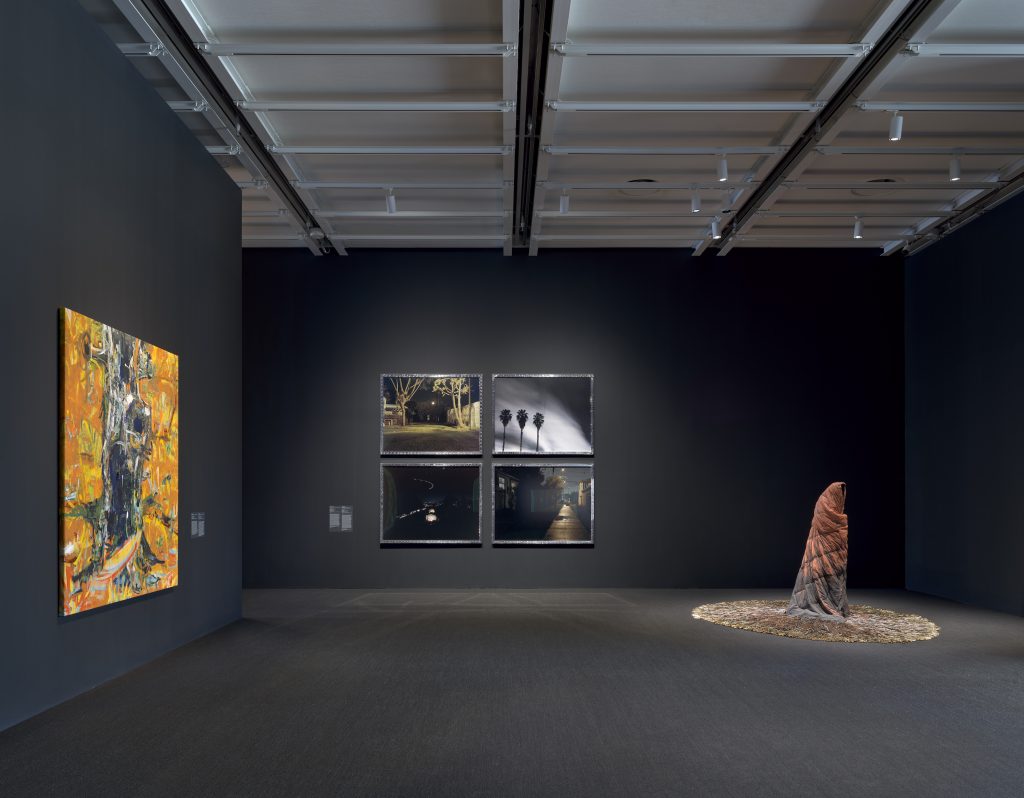
Installation view of Whitney Biennial 2022: Quiet as It’s Kept, Whitney Museum of American Art, New York, NY, USA. Photograph by Ron Amstutz.
A cloaked figure called ishkode (fire) by Anishinabe artist Rebecca Belmore (b. 1960) of Vancouver, Canada, stands upon a circular arrangement of empty bullet casings. The upright form of this enigmatic sculpture suggests that a human body is completely concealed within the protective cocoon of a sleeping bag. The contrast between the standing figure and the metallic halo of empty bullet casings below, although stunning, references systematic acts of violence and the vulnerabilities of the human body. Ominous for its suggestion of erasure and displacement, this form can also be seen as a phoenix rising from the flames.
Born in Fort Defiance, Navajo Nation, Raven Chacon’s (b. 1977) sound installation Silent Choir is discreet and easy to miss but demands discussion. The piece consists of the recorded audio from a silent demonstration that was led by the women of the Standing Rock Sioux Reservation in North Dakota in protest of the Dakota Access Pipeline. The silent standoff between security guards and those opposed to a pipeline that would have destroyed a primary local water source lasted several months from 2016 to 2017.
This outdoor recording is barely audible, indistinct, and an abstract collection of small yet sinister sounds such as that of the law enforcement officers’ radios, surveillance drones, the click of weapons and clinking of tear gas canisters. These sounds underscore aggressions that continue to place Indigenous peoples and their land in perpetual and mortal danger. Candice Hopkins’s essay for the exhibition catalogue explains that following centuries of ecocide and genocide, the struggle to assert one’s rights to a viable existence is as urgent as ever.
Through the women’s silence, the actions of those defending the rights of the corporation, their use of extreme violence to guard this nonliving entity, their debasing the health of the water and the people were thrown into sharp relief. White economies are predicated on Native death. The destruction of ecosystems is one part of their formation and their maintenance. But the more numerous the witnesses, the harder it is to commit the crime.
“Heed the Call: A Score for Resistance,” Whitney Biennial 2022 Quiet as It’s Kept, exh. cat., p. 139.
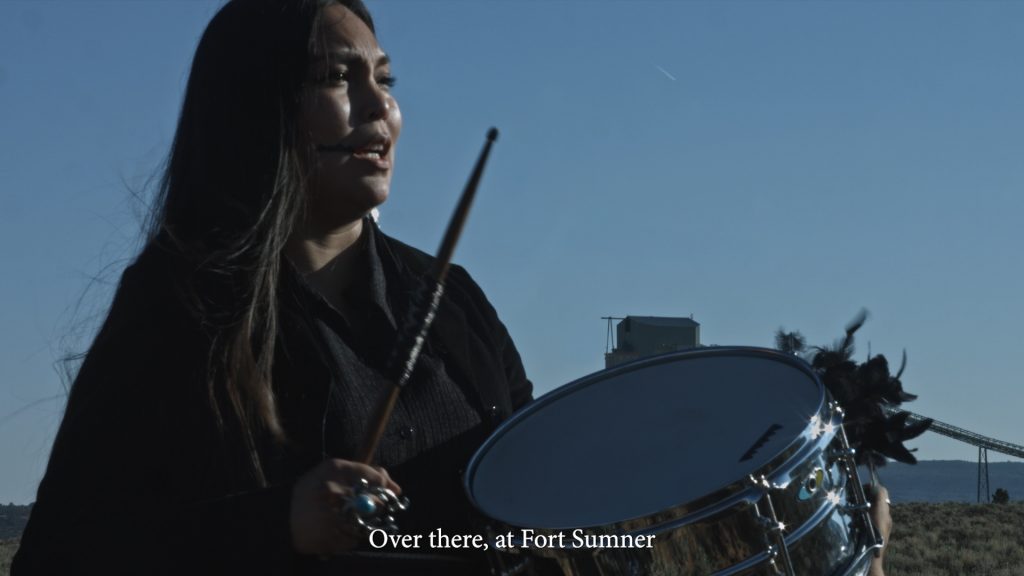
Raven Chacon, still from Three Songs, video installation, 2021. Image courtesy of the artist
In contrast to the silence, Chacon’s video installation Three Songs features American Indian women on separate screens, each singing passionately in their mother tongues about the history of the landscape where they stand. These are places where their ancestors faced conflict, displacement and massacres. Whether it is through the performance of song or silent protest, Chacon is listening to the past, present, and future of the landscapes and the struggles of Indigenous communities to preserve life and nature.
The visual and sensory intensity of the Chilean-born and New York-based artist Alfredo Jaar’s (b. 1956) video, 06.01.2020 18.39, masterfully captures the height of emotion that swept across this nation in June of 2020 following the murder of George Floyd. Jaar’s video documents peaceful protestors in support of the Black Lives Matter movement attempting to exercise their right to demonstrate in Washington DC.
Not only do we witness the violent response of federal forces but the artist included industrial-strength fans and additional audio to replicate the militarized use of helicopters that were flown low to the ground in an effort to physically and violently disperse the crowds. To use helicopters in this manner is prohibited by international human rights law yet it happened less than two years ago and right in front of the White House. This gut-wrenching and mind-blowing video installation is a sobering glimpse into of the disproportionate response and excessive use of force used to extinguish desperate pleas for the right to exist.
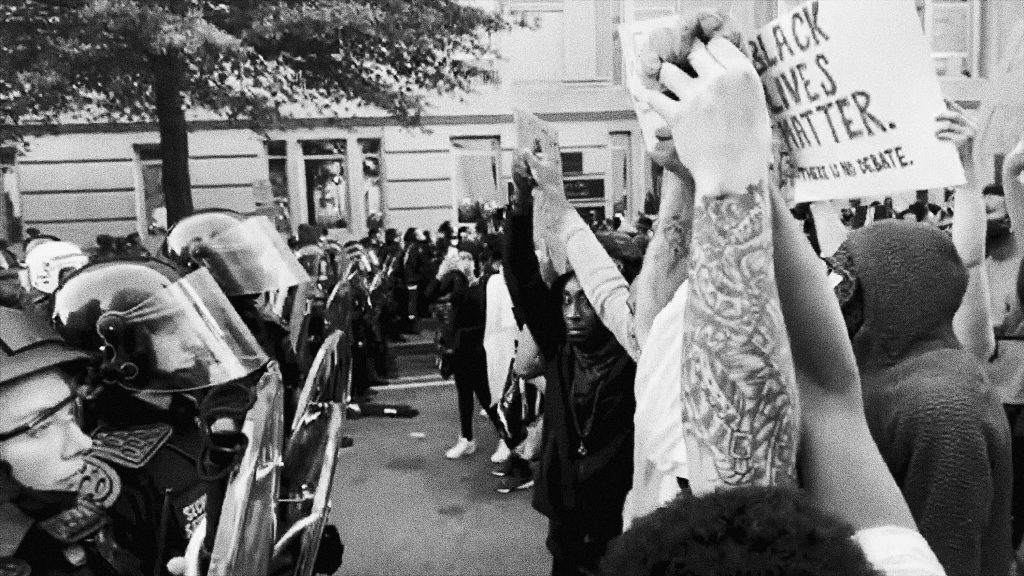
Alfredo Jaar, still from 06.01.2020 18.39, video projection, 2022. Collection of the artist. Courtesy the artist and Galerie Lelong & Co., New York and Paris.
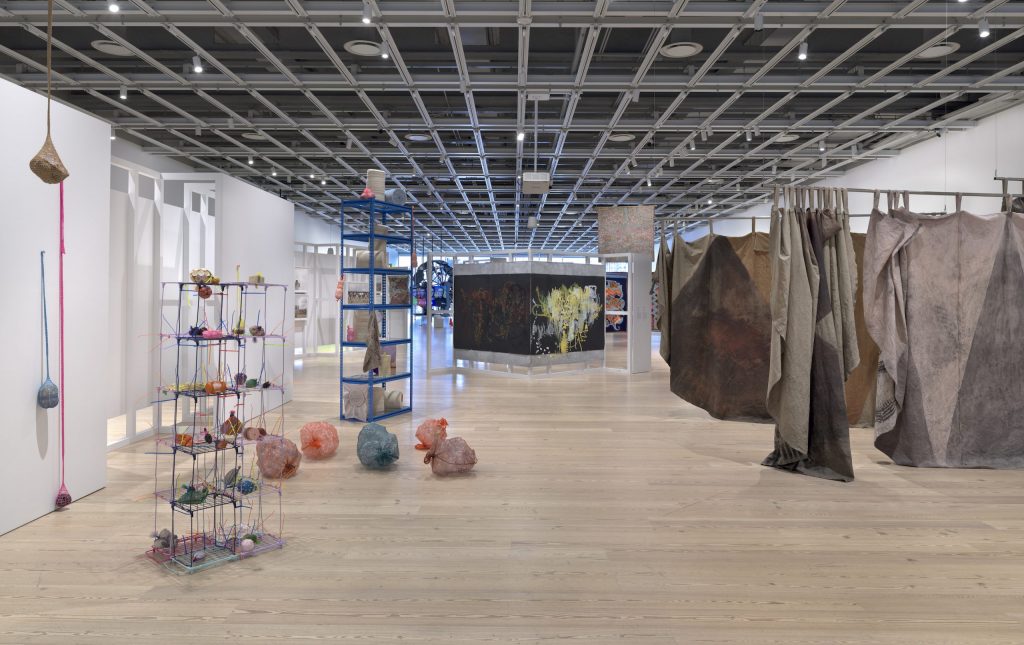
Installation view of Whitney Biennial 2022: Quiet as It’s Kept, Whitney Museum of American Art, New York, NY, USA, from left to right: Veronica Ryan, Between a Rock and a Hard Place, 2022; Awilda Sterling-Duprey, . . . blindfolded, 2020–; Duane Linklater, a selection from the series mistranslate_wolftreeriver_ininîmowinîhk and wintercount_215_kisepîsim, 2022. Photograph by Ron Amstutz.
Open Borders
In contrast to the darkness on one floor, the Biennial’s other main floor is an open and bright space without partitions that upon first impression is overwhelming and chaotic. There is a lot to see at once, and it takes some time to make one’s way around, sometimes in circles, and fully comprehend this space. I was immediately drawn to the abstract paintings of Chicago-based artist Lisa Alvarado (b. 1982) and Canadian artist Duane Linklater (b. 1976) that are suspended in space and demand to be looked at from all sides.
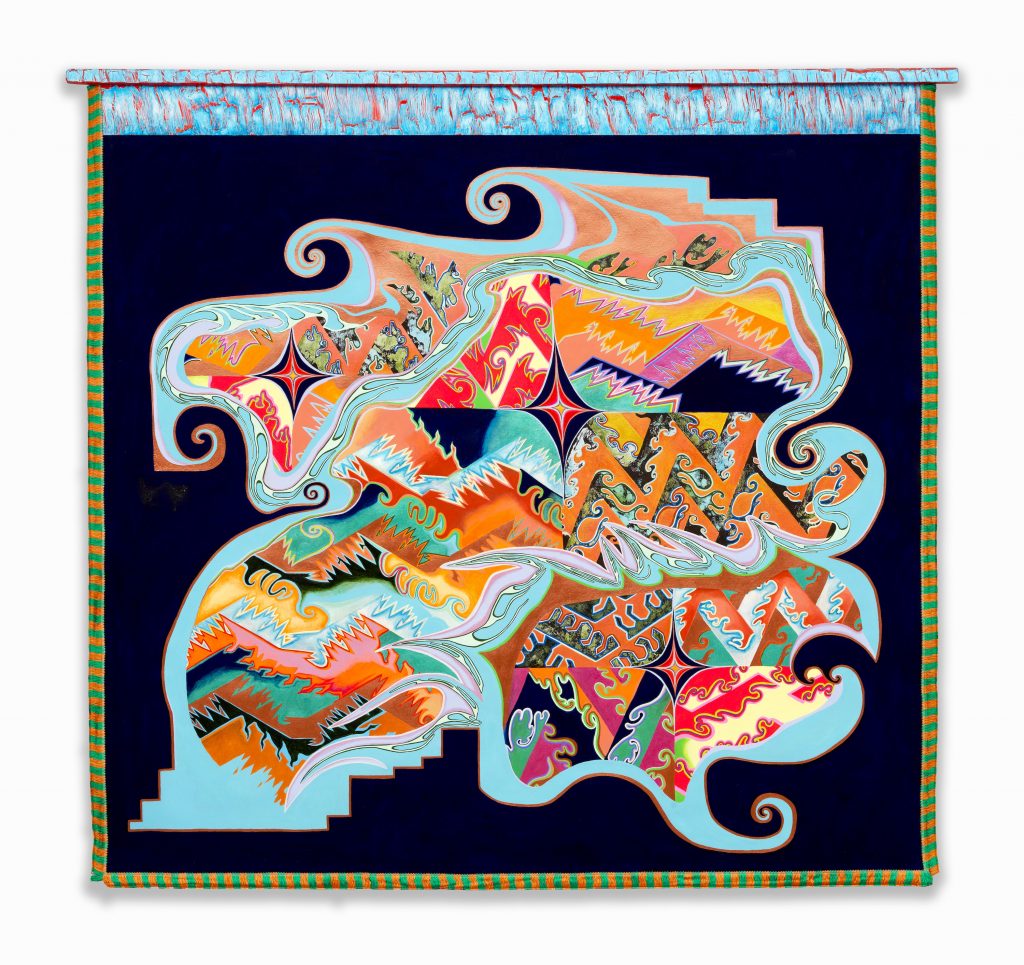
Lisa Alvarado, a selection from the series Vibratory Cartography: Nepantla, 2021-2022. Courtesy the artist; Bridget Donahue, New York; LC Queisser, Tbilisi; and The Modern Institute / Toby Webster Ltd, Glasgow.
A 60-minute video playing on a large screen and in an open area by the Philadelphia-based artist Alex Da Corte (b. 1980) was another pleasant experience. Appearing in full costume as Marcel Duchamp, Da Corte’s video is captivating on its own but unexpectedly enriched by the distractions swirling around this open viewing space.
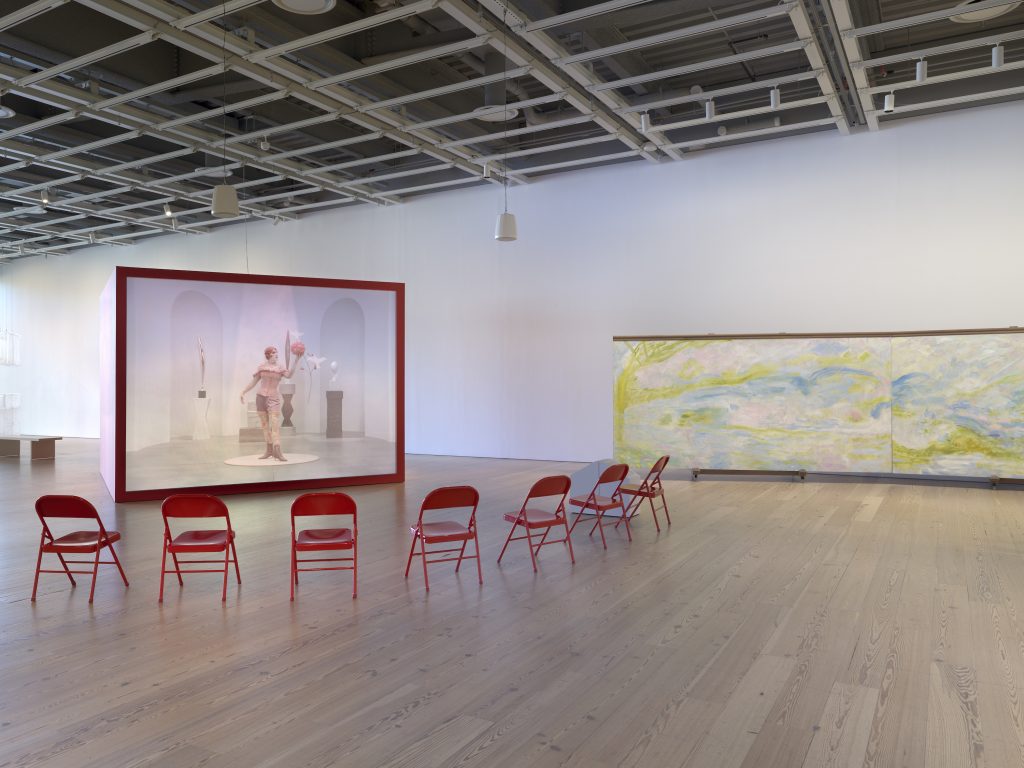
Installation view of Whitney Biennial 2022: Quiet as It’s Kept, Whitney Museum of American Art, New York, NY, USA, from left to right: Alex Da Corte, ROY G BIV, 2022; Leidy Churchman, Mountains Walking, 2022. Photograph by Ron Amstutz.
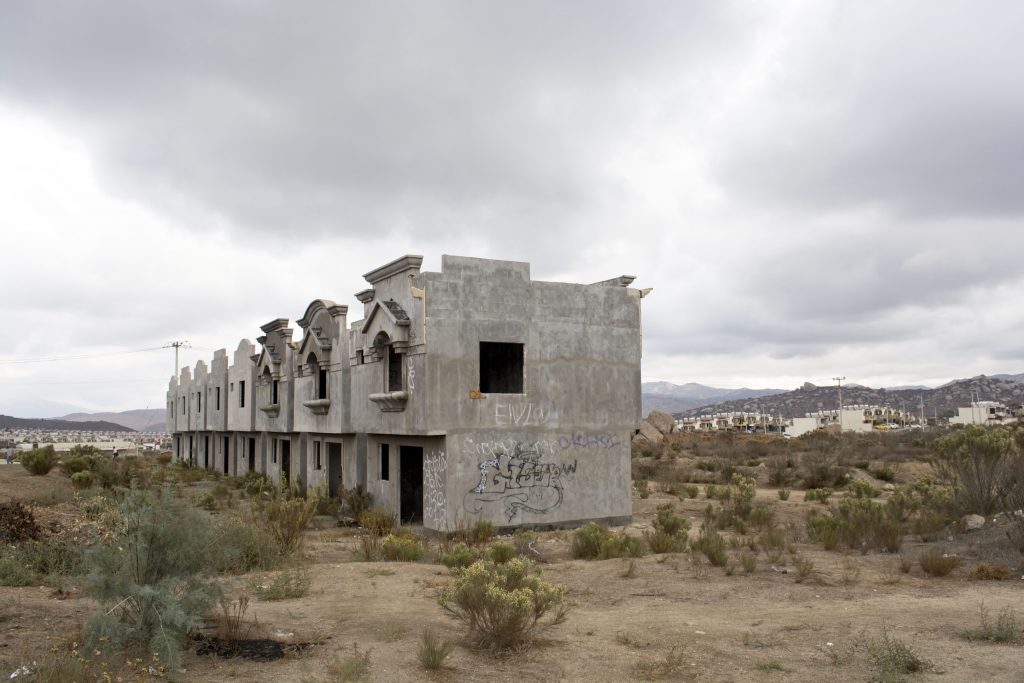
Mónica Arreola, Untitled from Valle San Pedro, 2018. Collection of the artist.
Tijuana-based photographer and architect Monica Arreola documented the remains of buildings in the Valle San Pedro that were abandoned mid-construction following the 2008 financial collapse due to the US housing market crash. These photographs depict the architectural ruins of this Mexican border town and the failures of a government-backed real estate initiative that sought to transform this region into a profitable community with opportunities for growth. The ghostly remains of dangerous locations in Arreola’s large and gloomy photographs are shown from the perspective of an insider, one who is an active citizen of this region and member of the local arts community.
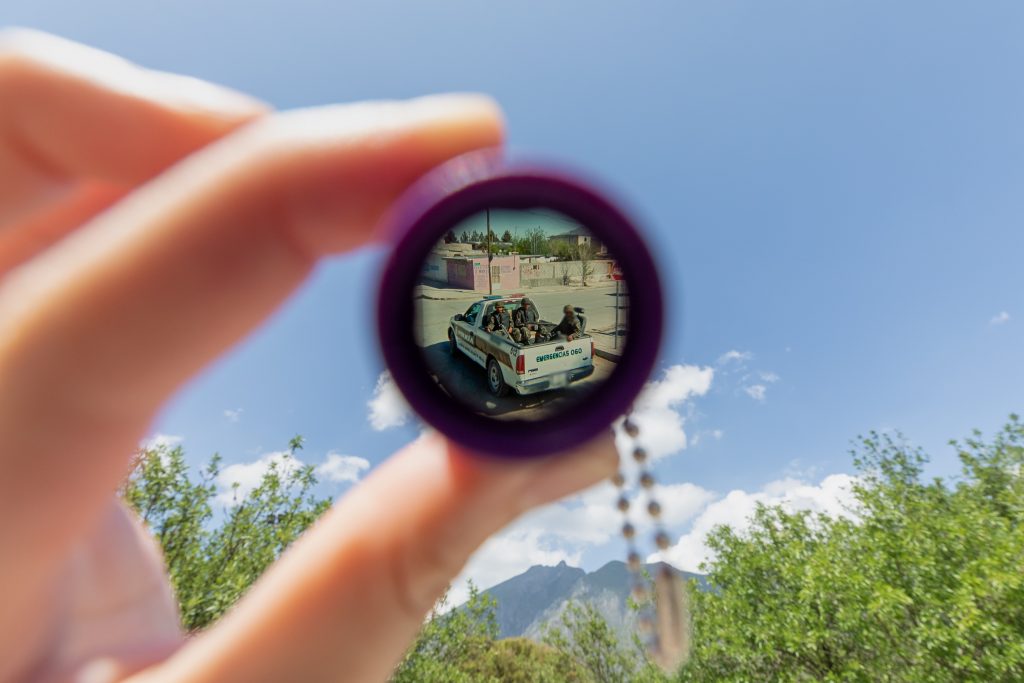
Alejandro “Luperca” Morales, Juárez Archive (7512 Maravillas Street), 2020-. Image courtesy the artist. Photograph by Michelle Lartigue.
Alejandro “Luperca” Morales’s (b. 1990) installation Juárez Archive is a series of vignettes featuring the artist’s hometown of Ciudad Juárez through images sourced from Google Maps during the pandemic when the artist was unable to visit in person. The satellite photographs and street view shots that populate Google Maps make it is possible to zoom in on almost any location around the globe. Rummaging around a digital archive accessible to all with internet access, Morales selected images from specific locations around his city that expose the impact of the violent drug wars in that region.
Images captured for utilitarian and mundane purposes are employed to tell personal stories. Seen through pocket-size viewfinders, the kind sold in souvenir shops, hanging from long chains and in a long row along a wall, these portable objects are paired with brief descriptions of the misfortunes faced by the local residents of each location. Interactive and intimate, the act of holding each viewfinders is as captivating as the content within. These impersonal moments captured with cameras not operated by humans are given a personal touch through the artist’s thoughtful selection and loving presentation.
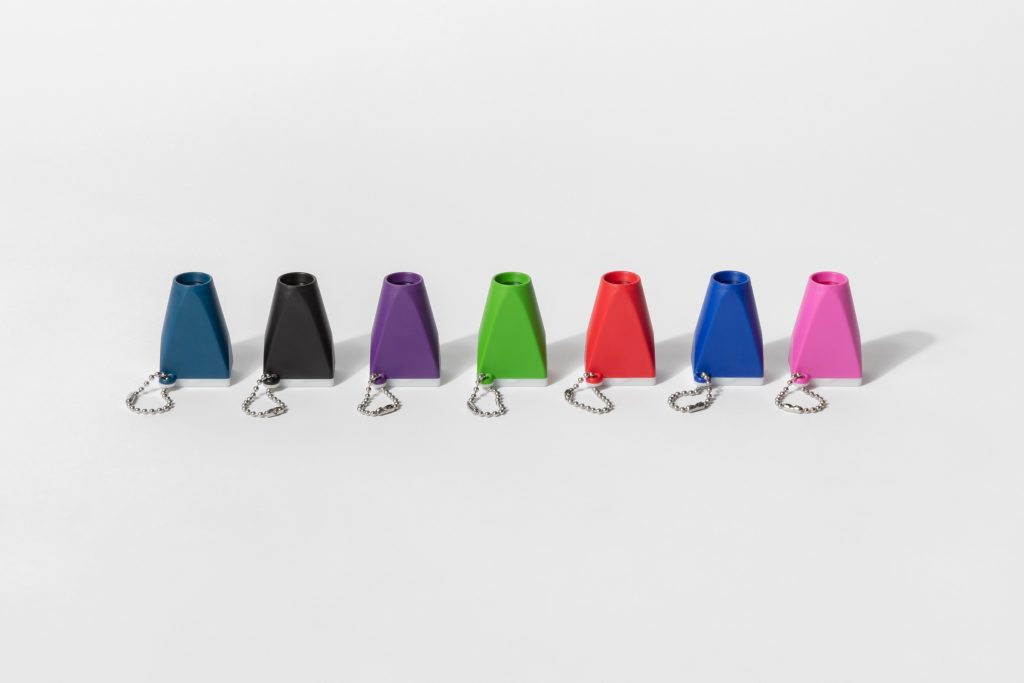
Alejandro “Luperca” Morales, Juárez Archive, 2020-. Image courtesy the artist. Photograph by Michelle Lartigue.
Zombie capitalism is the subject of Tijuana and Mexico City-based artist Andrew Roberts’ (b. 1995) digital billboards influenced by the violent dramas streaming across the media platforms of the corporate giants dominate our mental spaces with that of the Mexican drug wars as witnessed by artist throughout his childhood. The digital decay of these slick billboards promote dystopian nightmares, imagined and real, that remain at a distance for some but are a daily reality for others.
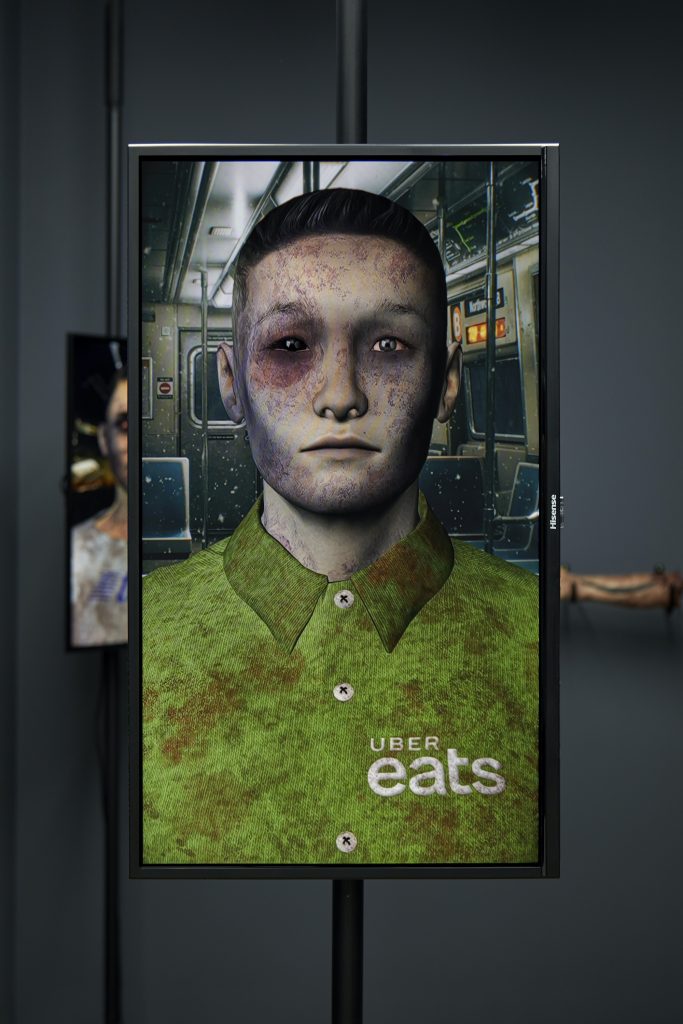
Andrew Roberts, La Horda (The horde), video installation, 2020. Collection of Mauricio Galguera. Image courtesy the artist and Pequod Co., Mexico City. Photograph by Sergio López. Detail.
The vivid colors and lush surfaces of New York artist Jane Dickson’s paintings look back at the neons signs and billboards of Times Square as photographed by the artist from inside her apartment decades ago. These dreamy paintings are materially seductive, emblazoned with text that is deceptively hopeful because they refer to streets where crime was common years ago, the same streets that two years ago were eerily empty during the shutdown and that today can barely withstand the steep inequities brought on by the pandemic.
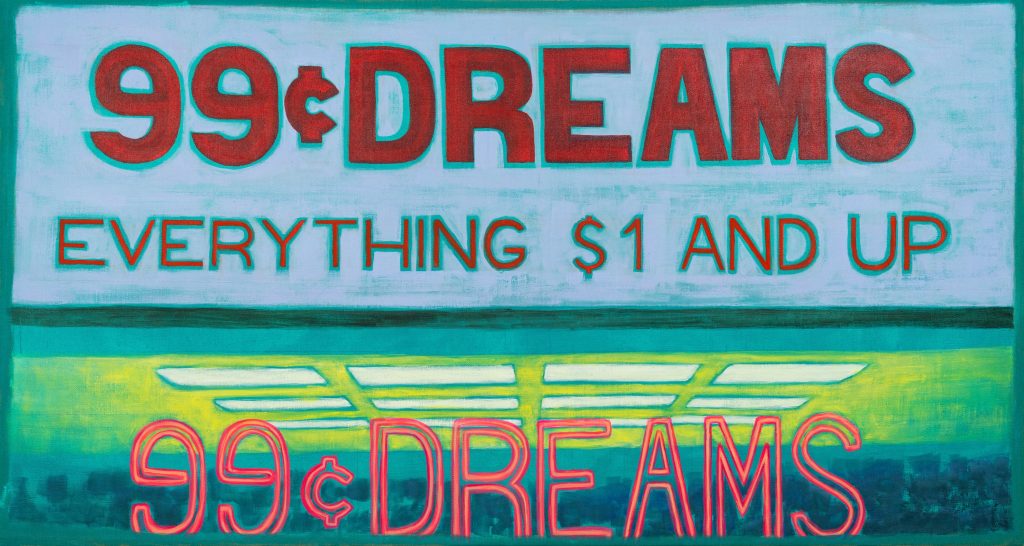
Jane Dickson, 99¢ Dreams, 2020. Collection of the artist.
Korean-American artist Theresa Hak Kyung Cha (1951-1982) is the subject of a mini-retrospective featuring a brilliant career tragically cut short. Cha’s multidisciplinary investigation of language, identity and displacement grew out of her experiences as an immigrant whose family moved multiple times around Asia and eventually to the US.
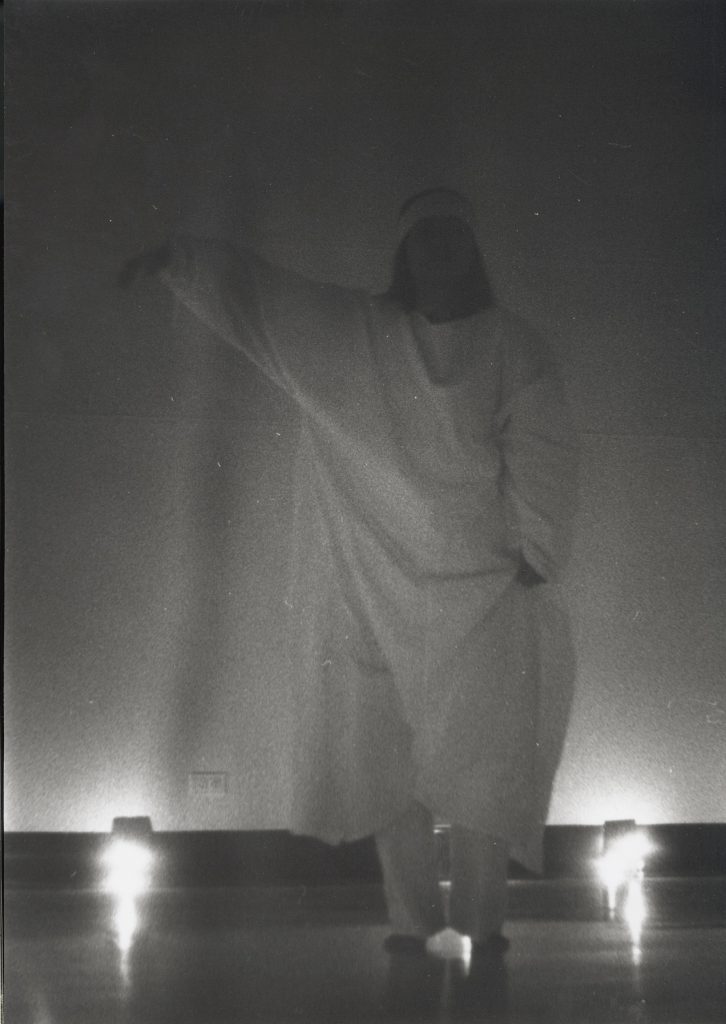
Theresa Hak Kyung Cha, A Ble Wail, documentation of performance at Worth Ryder Gallery, University of California, Berkeley, CA, 1975. Image courtesy the University of California, Berkeley Art Museum and Pacific Film Archive; gift of the Theresa Hak Kyung Cha Memorial Foundation.
64,000 Attempts at Circulation is a detailed catalogue and elaborate display of coins acquired by the New York City-based artist Rose Salane (b. 1992) from the New York Metropolitan Transit Authority.
These coins that bear no value come from places such as amusement parks or carnivals, churches and foreign countries and represent the attempts of mass transit riders to trick the system, either intentionally or unknowingly. Every coin is linked to a person and a story and together they represent the anonymous masses, an invisible workforce whose livelihood relies on the mass transit system.
In closing, the Whitney Biennial makes room for artists to confront secrets of the past, present and future that are unknown, denied or forgotten. The open and self-reflective conceptual work of curators and artists deeply engaged with uncomfortable truths that implicate systems and institutions, including the one hosting this exhibition, is a laudable step forward.
